WEISSMANN’S TAROT
Weissmann’s Tarot is better than Slothrop’s. Here are the real cards, exactly as they came up.
Significator: Knight of Swords
Covered by: The Tower
Crossed by: Queen of Swords
Crowning: King of Cups
Beneath: Ace of Swords
Before: 4 of Cups
Behind: 4 of Pentacles
Self: Page of Pentacles
House: 8 of Cups
Hopes and Fears: 2 of Swords
What will come: The World
From page 746 of Gravity’s Rainbow.
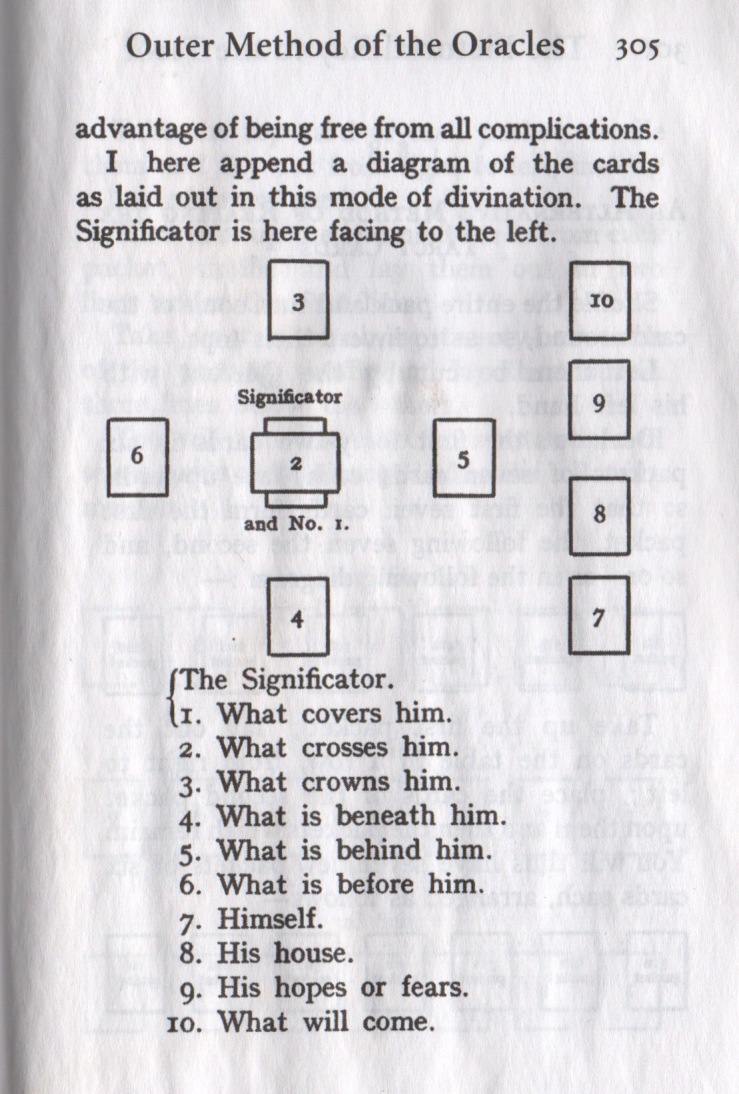
He appears first with boots and insignia shining as the rider on a black horse, charging in a gallop neither he nor horse can control, across the heath over the giant grave-mounds, scattering the black-faced sheep, while dark stands of juniper move dreamily, death-loving, across his path in a parallax of unhurrying fatality, presiding as monuments do over the green and tan departure of summer, the dust-colored lowlands and at last the field-gray sea, a prairie of sea darkening to purple where the sunlight comes through, in great circles, spotlights on a dancing-floor.
He is the father you will never quite manage to kill. The Oedipal situation in the Zone these days is terrible. There is no dignity. The mothers have been masculinized to old worn moneybags of no sexual interest to anyone, and yet here are their sons, still trapped inside inertias of lust that are 40 years out of date. The fathers have no power today and never did, but because 40 years ago we could not kill them, we are condemned now to the same passivity, the same masochist fantasies they cherished in secret, and worse, we are condemned in our weakness to impersonate men of power our own infant children must hate, and wish to usurp the place of, and fail… . So generation after generation of men in love with pain and passivity serve out their time in the Zone, silent, redolent of faded sperm, terrified of dying, desperately addicted to the comforts others sell them, however useless, ugly or shallow, willing to have life defined for them by men whose only talent is for death.
Of 77 cards that could have come up, Weissmann is “covered,” that is his present condition is set forth, by The Tower. It is a puzzling card, and everybody has a different story on it. It shows a bolt of lightning striking a tall phallic structure, and two figures, one wearing a crown, falling from it. Some read ejaculation, and leave it at that. Others see a Gnostic or Cathar symbol for the Church of Rome, and this is generalized to mean any System which cannot tolerate heresy: a system which, by its nature, must sooner or later fall. We know by now that it is also the Rocket.
Members of the Order of the Golden Dawn believe The Tower represents victory over splendor, and avenging force. As Goebbels, beyond all his professional verbalizing, believed in the Rocket as an avenger.
On the Kabbalist Tree of Life, the path of The Tower connects the sephira Netzach, victory, with Hod, glory or splendor. Hence the Golden Dawn interpretation. Netzach is fiery and emotional, Hod is watery and logical. On the body of God, these two Sephiroth are the thighs, the pillars of the Temple, resolving together in Yesod, the sex and excretory organs.
But each of the Sephiroth is also haunted by its proper demons or Qlippoth. Netzach by the Ghorab Tzerek, the Ravens of Death, and Hod by the Samael, the Poison of God. No one has asked the demons at either level, but there may be just the wee vulnerability here to a sensation of falling, the kind of very steep and out-of-scale fall we find in dreams, a falling more through space than among objects. Though the different Qlippoth can only work each his own sort of evil, activity on the path of The Tower, from Netzach to Hod, seems to’ve resulted in the emergence of a new kind of demon (what, a dialectical Tarot? Yes indeedyfoax! A-and if you don’t think there are Marxist-Leninist magicians around, well you better think again!). The Ravens of Death have now tasted of the Poison of God… but in doses small enough not to sicken but to bring on, like the Amanita muscaria, a very peculiar state of mind… . They have no official name, but they are the Rocket’s guardian demons.
Weissmann is crossed by the Queen of his suit. Perhaps himself, in drag. She is the chief obstacle in his way.
At his foundation is the single sword flaming inside the crown: again, Netzach, victory. In the American deck this card has come down to us as the ace of spades, which is a bit more sinister: you know the silence that falls on the room when it comes up, whatever the game.
Behind him, moving out of his life as an influence, is the 4 or Four of Pentacles, which shows a figure of modest property desperately clutching on to what he owns, four gold coins—this feeb is holding two of them down with his feet, balancing another on his head and holding the fourth tightly against his stomach, which is ulcerous. It is the stationary witch trying to hold her candy house against the host of nibblers out there in the dark.
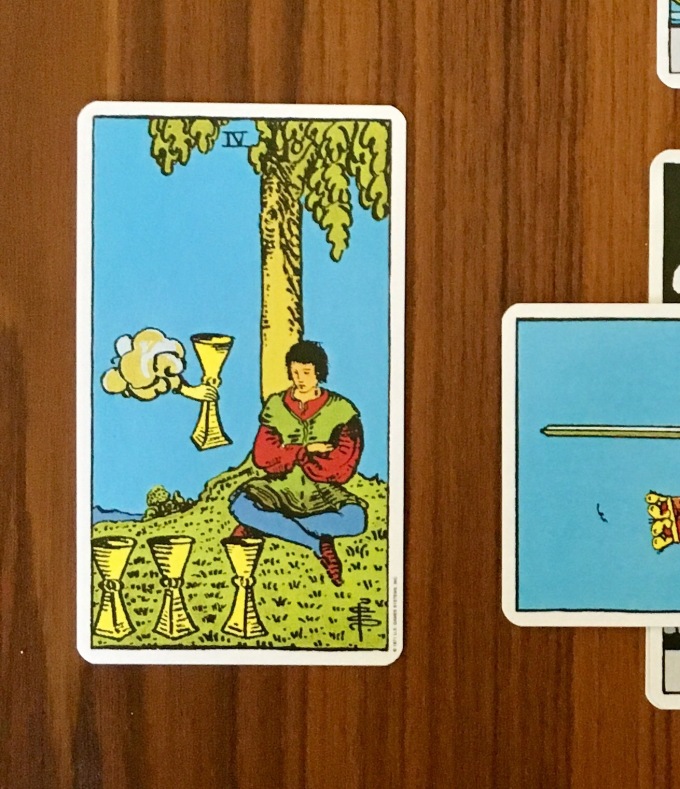
Moving in, before him, comes a feast of cups, a satiety. Lotta booze and broads for Weissmann coming soon.
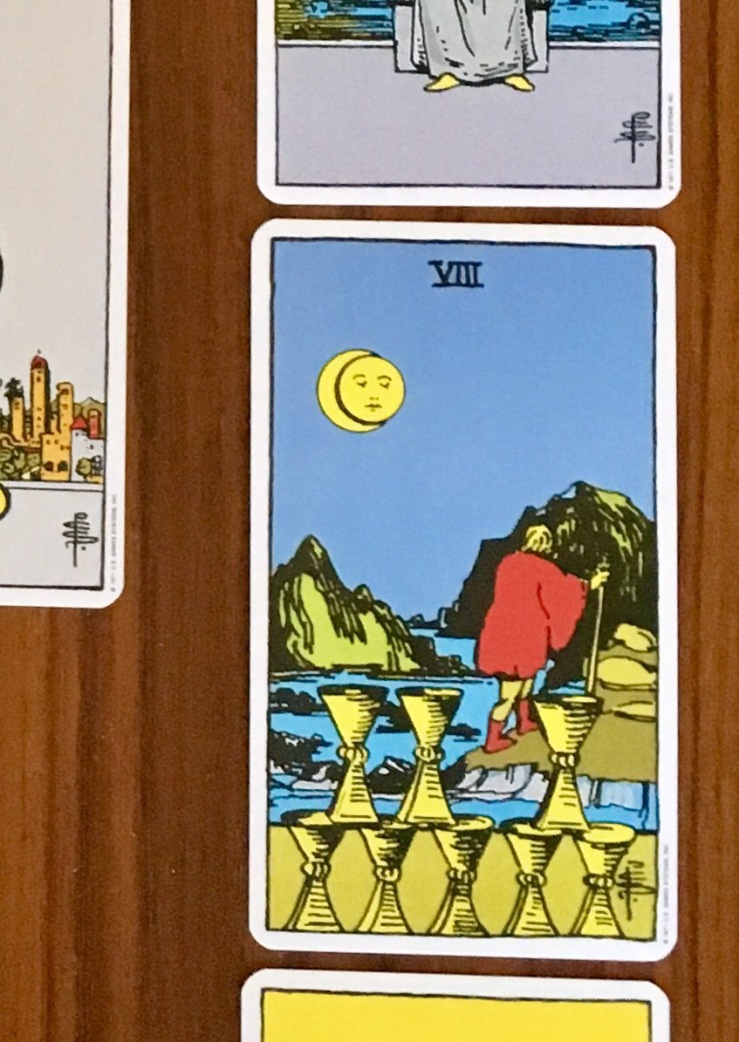
Good for him—although in his house he is seen walking away, renouncing eight stacked gold chalices. Perhaps he is to be given only what he must walk away from.

Perhaps it is because in the lees of the night’s last cup is the bitter presence of a woman sitting by a rocky shore, the Two of Swords, alone at the Baltic edge, blindfolded in the moonlight, holding the two blades crossed upon her breasts… the meaning is usually taken as “concord in a state of arms,” a good enough description of the Zone nowadays, and it describes his deepest hopes, or fears.
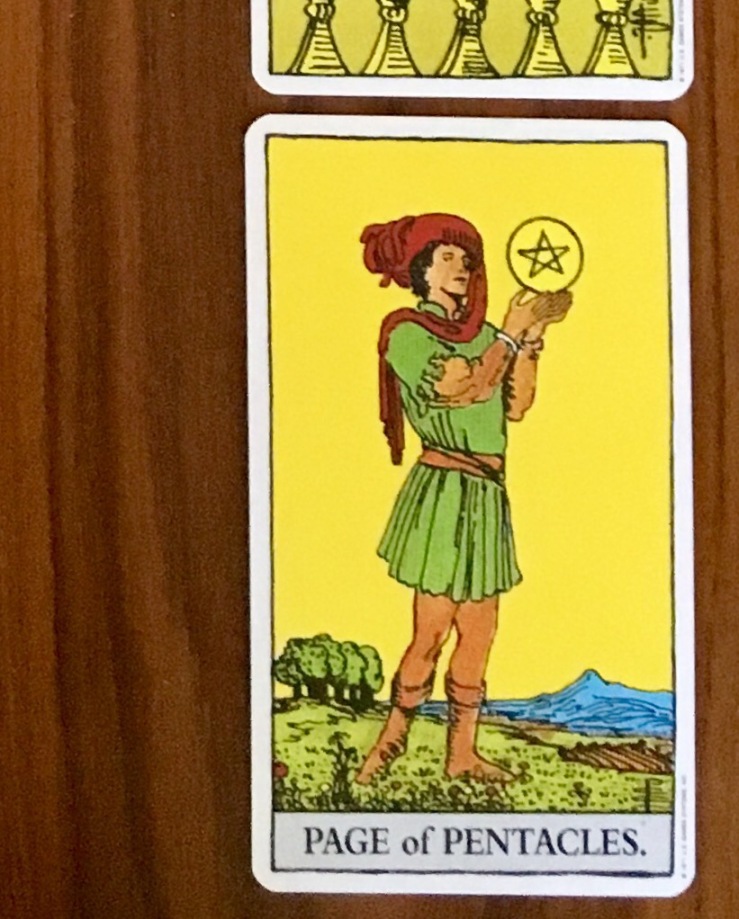
Himself, as the World sees him: the scholarly young Page of Pentacles, meditating on his magic gold talisman. The Page may also be used to stand for a young girl. But Pentacles describe people of very dark complexion, and so the card almost certainly is Enzian as a young man. And Weissmann may at last, in this limited pasteboard way, have become what he first loved.
The King of Cups, crowning his hopes, is the fair intellectual-king.
If you’re wondering where he’s gone, look among the successful academics, the Presidential advisers, the token intellectuals who sit on Presidential advisers, the token intellectuals who sit on boards of directors. He is almost surely there. Look high, not low.
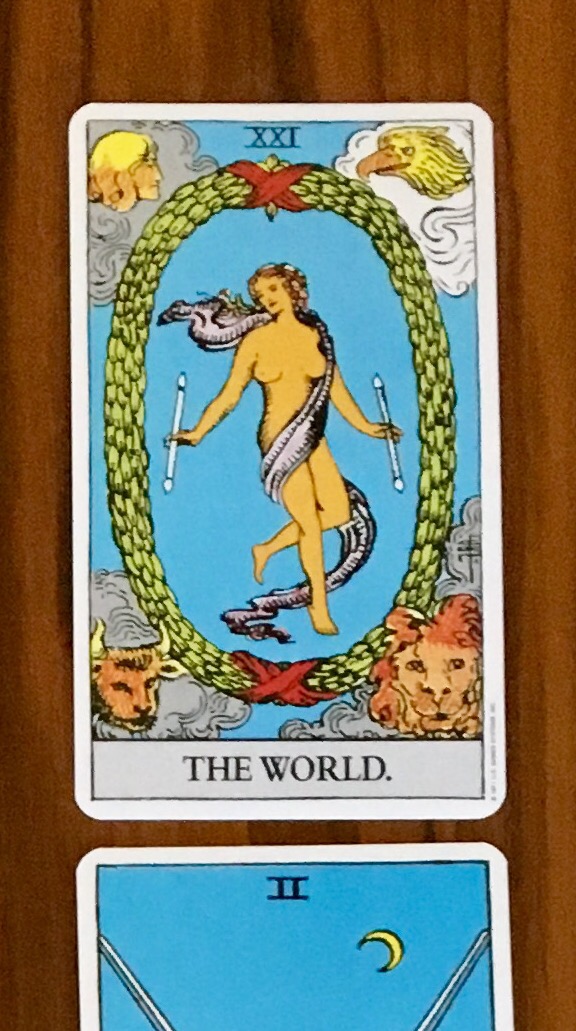
His future card, the card of what will come, is The World.
The language in this post is from pages 746-49 of Thomas Pynchon’s novel Gravity’s Rainbow. Elements of this post found their way into some annotations I made a few years ago on page 539 of Gravity’s Rainbow.

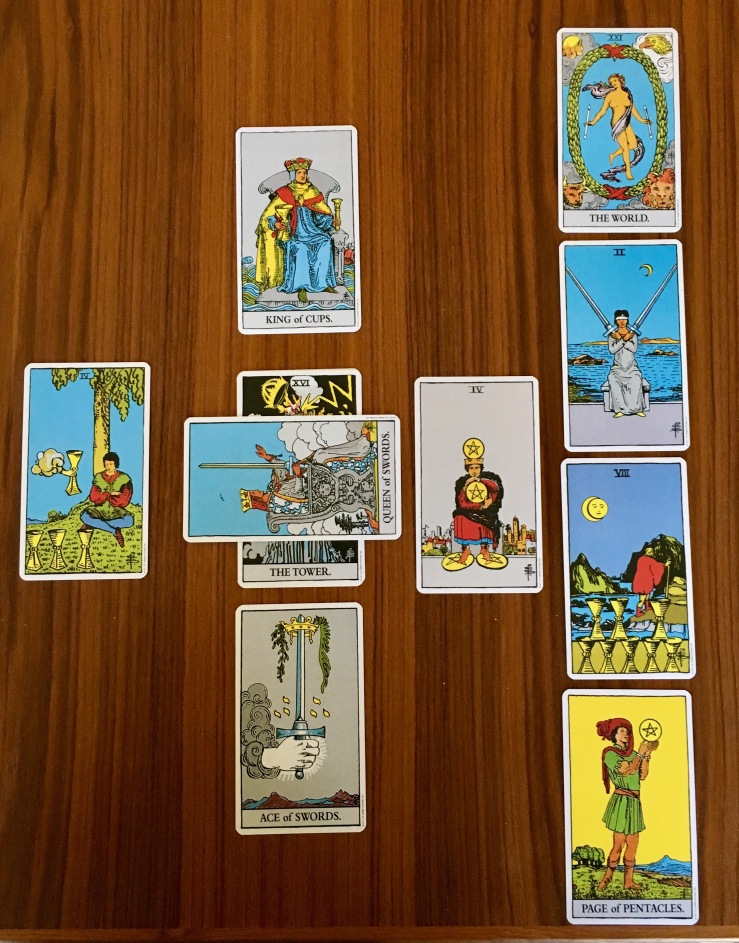


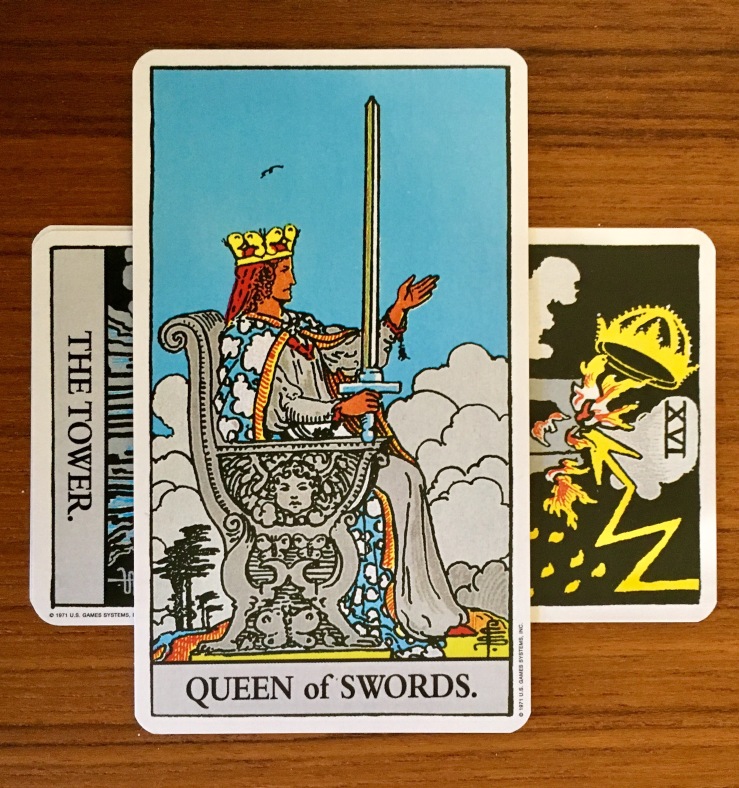


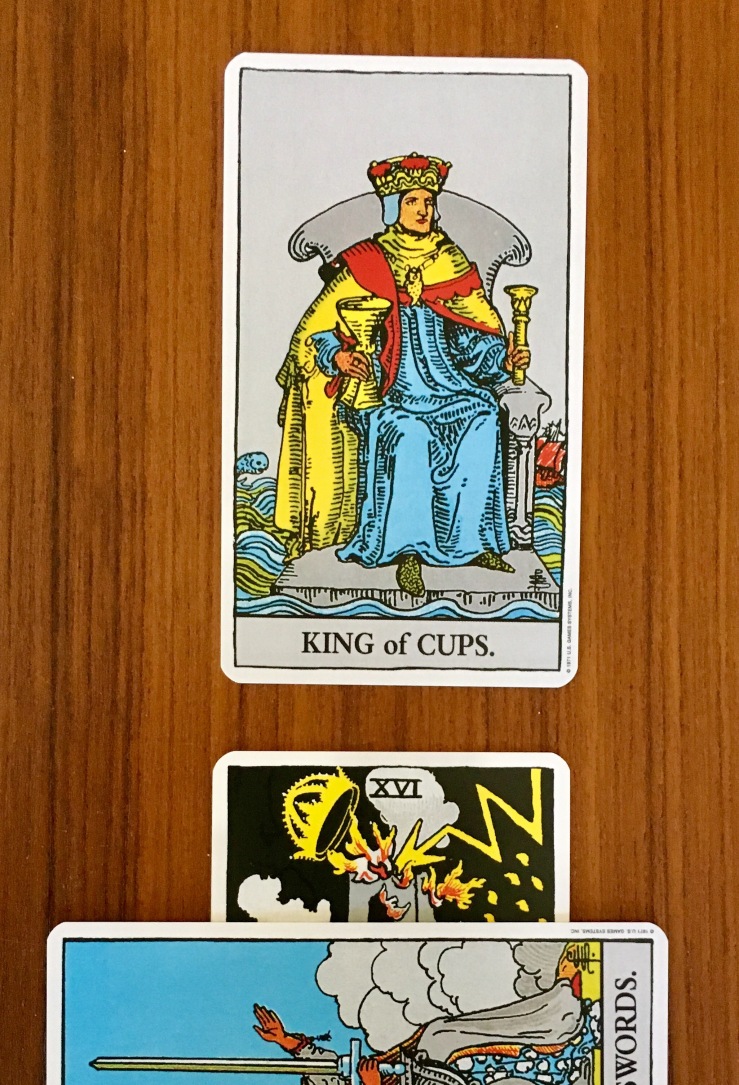
I deleted a bunch of old drafts this afternoon, and in this process, came across this post.
I made this at the end of November, 2016. I was rereading Gravity’s Rainbow, playing with tarot cards all the time, drinking way too much, and going more than a little crazy.
The draft for this post had a bunch of wild, mildly-insane notes at the end. I don’t think I meant to simply quote a bunch of Pynchon, but rather to riff on the end of the novel—on fate and control, on entropy and a guiding hand. Again, I think I was really going a little bit crazy (I don’t say that lightly. It took me like two years to get better, to be honest).
I had other notes on Gravity’s Rainbow, drafts that I deleted, and I now remember this weird paralysis/tic I fell into with the end of the book and with rereading the first page. I ended up reading a ton of stuff on Richard Nixon and Wernher von Braun—watching a documentary on von Braun, then checking out books on him, stuttering on the first page of Gravity’s Rainbow, reading up on the concept of zero. And laying out tarot cards every day. The drafts I deleted were lots and lots of words—-most not mine, most copied with my annotations, starting places for Something—on like the first three pages of Gravity’s Rainbow. I think my intention was just to keep rereading the book forever, keep writing about it. I can’t recall how I Snapped Out Of It, but I did.
Anyway, when I came across this post this afternoon, while deleting old drafts—mostly reviews that I never committed to finishing, or other weird tossed off riffs—literally hundreds of these things—I couldn’t bear to delete this one. It seemed finished in some way, although I can tell that I didn’t think it was finished. I mean, Pynchon finished it. I guess it’s just a reference. I don’t know why I’m writing this now. Peace.
LikeLike
You must miss your neighbor Greg now and then
LikeLike
I do. We meet every few weeks ago for lunch and drinks, but it’s not the same.
LikeLike
Is the second “as” from the quote below a typo in your copy of GR? If so, would you please send the relevant info to bookerrata.com so we can keep our database properly updated?
“Members of the Order of the Golden Dawn believe The Tower represents victory over splendor, and avenging force. As Goebbels, beyond all his professional verbalizing, believed in the Rocket as as an avenger.”
LikeLike
The error is in my transcription, not in my copy of GR.
LikeLike
Thank you for letting me know. I’ve found a few Pynchon typos over the years, but relative to the density of his prose, very few as compared with other authors. Thanks again.
LikeLike
Always love these posts. Quality as always.
LikeLike